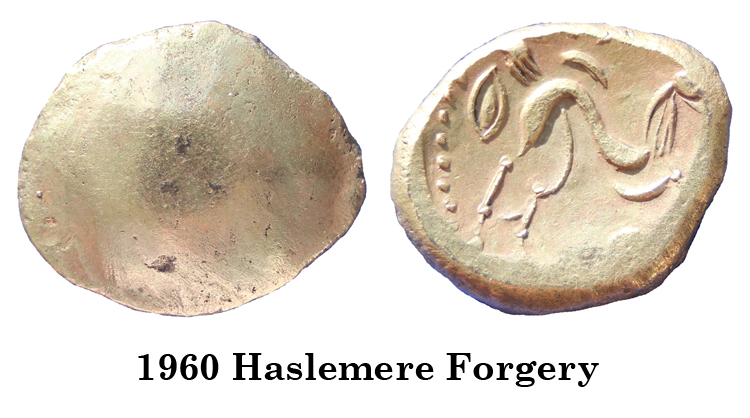Numismatic Articles
Van Arsdell 2014b (Info)
Modern Celtic Fakes 2
Haslemere Silver – some diagnostics
By Robert Van Arsdell
By 1962, the Haslemere Forger had successfully passed scores of phony gold staters on the market. Although some of them didn’t look anything like real staters, they were accepted as strange…but genuine.
The forger would now try his hand at making silver units and see if anyone spotted these. As it turns out, no one did. Why is it that the experts of the day failed to see what was happening?
It’s important to recognize that this was a trusting age (1). Serious Celtic collectors, dealers and scholars moved in circles that were close-knit and familiar. Everyone would naturally believe that this area of numismatics was too much of a backwater to attract criminal activity. Fakes happened to other people.
More importantly, scholars in the 1940s and 50s were finally making headway in explaining these enigmatic coins. Little progress had occurred since the time of Evans, and things were looking up. Scholars could now identify the tribal origin and date for many types (2) (3). A colourful pseudo-history had been written about the period, based on the numismatics (4). A new catalogue of types had recently been published (5).
By 1960, a small number of workers eagerly looked for every new piece of evidence – something to publish and expand our knowledge.
In this trusting, searching environment, the Haslemere Forger would operate with impunity for the next 25 years. Cheating people out of money was the least of his crimes. He successfully falsified the archaeological record (with almost catastrophic consequences) until his work was exposed in the 1980s.
Although a few of the Haslemere Forger’s silver fakes have been condemned, the details have never been published. Two of these illustrate the problems the forger faced and the methods he used to improve his work.
An important lesson to be learned is that the forger could make better fakes if he wanted. However, because the worst of his fakes was eagerly accepted, he had little incentive to work very hard. He might produce a miserable coin at one time, and a reasonably good one at another. There is no reason to believe that once he had produced better work, that he would continue making the effort.
The Early Days
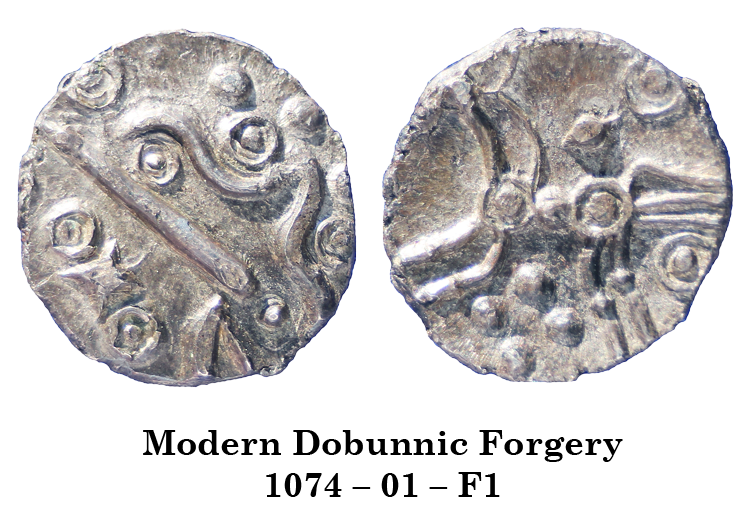
The coin illustrated above appeared in 1962 (6). It is amongst the earliest of the silver fakes. A Dobunnic silver unit (1074-01), it wasn’t fully condemned until June 1987.
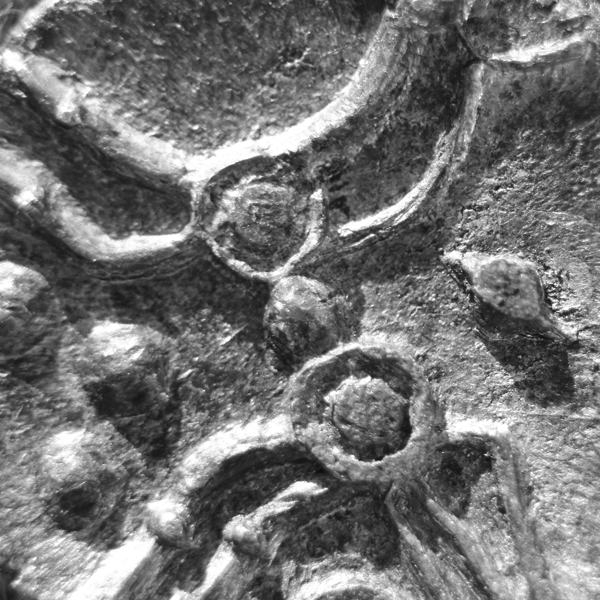
The first thing to notice is that the dies are cut deeply and the coin is well struck with good relief. At arm’s length it looks like a superb example of a Dobunnic silver unit. The forger, however, was having great difficulty cutting the small dies.
His earliest gold fakes had been noted as unusual (but not condemned) because of the “linear character of the design” (7). On these, he had cut the dies too shallow, and the resulting images looked “stringy” with low relief (See 1960 fake). Now chastened, the forger would try and do a better job.
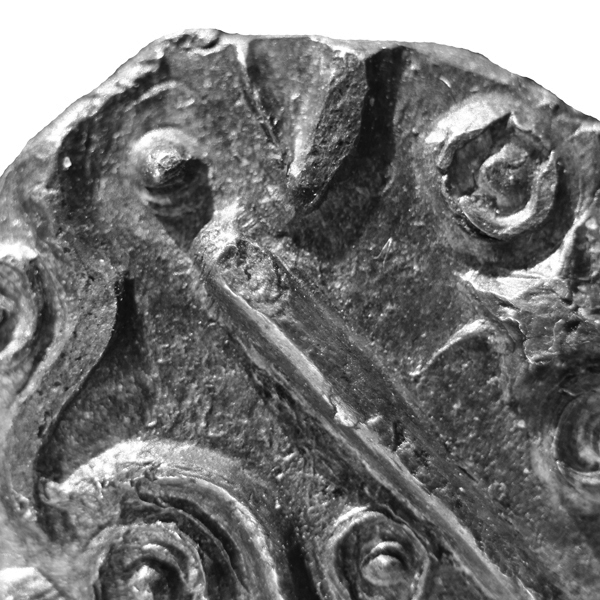
On the obverse of this silver unit, he cut almost every design element with multiple cuts to deepen the die. This gives us the usual thing to look for – the traditional “Haslemere steps”. But on this coin they scarcely appear at all. The next photo shows and enlarged view.
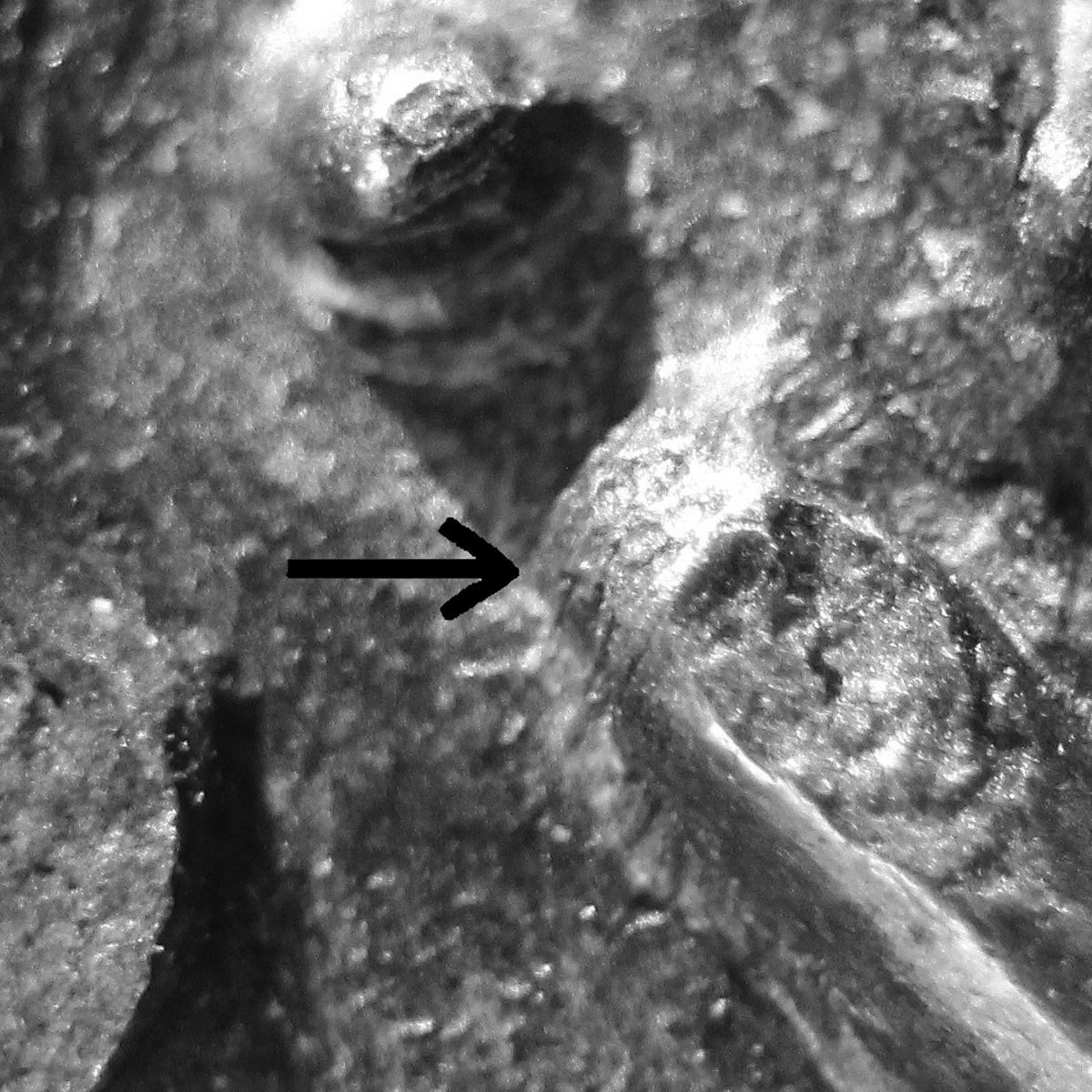
The only place they can be seen, and then only under high magnification, is at the end of the “spike” on the obverse (arrow).
But the multiple cuts produced two other mistakes. These have not been published, so the forger was never tipped off. He likely made these same mistakes over his entire career.
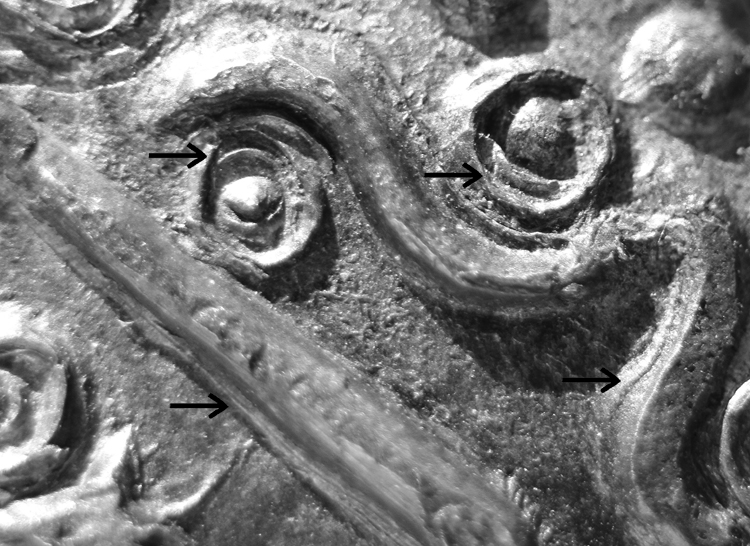
These errors appear on two different kinds of design elements. On linear elements (lines and curves) he failed to make each successive cut in the same place. The elements show multiple lines where only one should appear. Often, a line or curve splits in two and has two endpoints. I call these “Split End” errors.
Split End errors can be either multiple lines where only one should appear, or an actual splitting of the line into two or more strands.
On circular elements, the forger failed to cut a nice clean circle. Genuine coins, for the most part, have pellet-in-ring motifs with a perfect circle. Probably the ancient die cutters punched the circles using circular punches. The Haslemere Forger, instead, cut the circles with two or more strokes of a graver. Since these seldom mated, the circles are incomplete or have lines that overlap. I call this a “Split Ring” error.
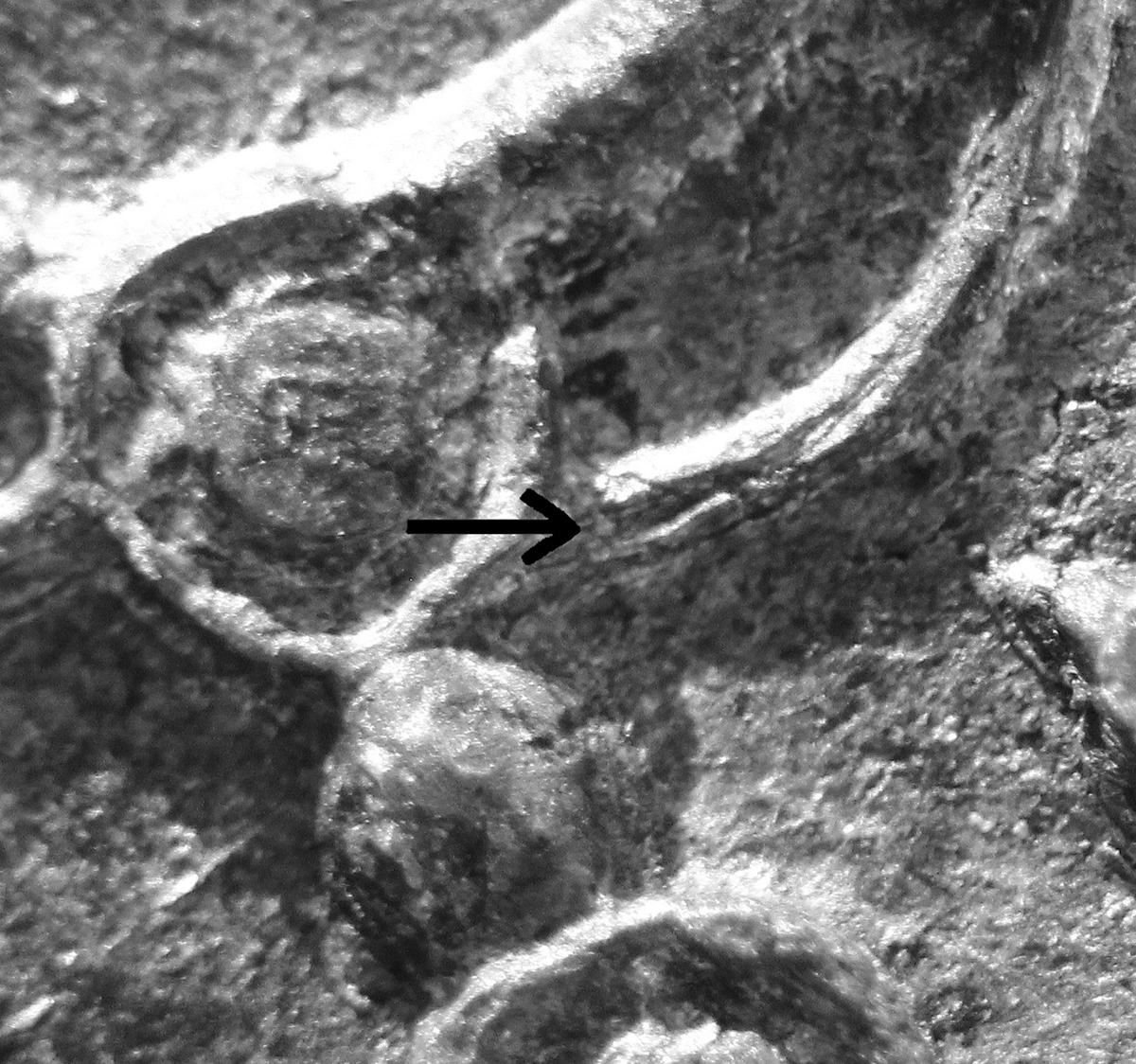
The reverse of the coin also shows a Split End error (arrow).
It is important to note, however, that a Celtic die cutter under duress could make the same mistakes. Although the vast majority of Celtic dies were expertly cut, occasionally one may see either error on a genuine coin. Thus, the Split End and Split Ring errors are not absolute proof of modern forgery. As always, an authenticator looks for combinations of errors before condemning a coin.
The Middle Years
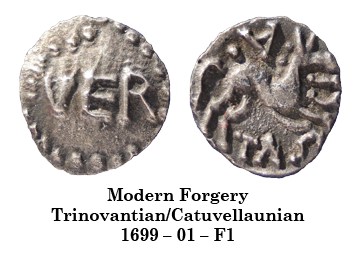
The coin illustrated above appeared in September 1982. It shows how the forger had improved his work. The coin, a silver unit of Tasciovanus (1699-01), wasn’t fully condemned until June 1987. It has reasonable relief and displays no obvious die cutting errors. Although it looks good at arms length, it can still be condemned.
The devices are all very unsharp for such a well-struck coin, and circulation wear does not seem to be the cause. By the 1980s, it was a common practice for forgers of modern coins to coat them with a black tar-like substance to antique them and hide their errors. This coin has an overall dark colour, but there doesn’t seem to be any heavy tar residue.
However, it was also common practice to clean genuine silver coins, because they would be found in a very oxidized state. By dipping a coin in liquid silver polish, the oxidation was removed, improving the appearance. The forger must have noticed that by dipping his fakes long enough, that they not only looked like genuine dipped coins, but that his die cutting errors could be completely eroded away. To do this, he had to dip a coin until the surfaces were completely eroded and porous. A subsequent “antiquing” step turned the coins black. This forgery displays the blackened colour, weak devices and porous surfaces of such treatment.
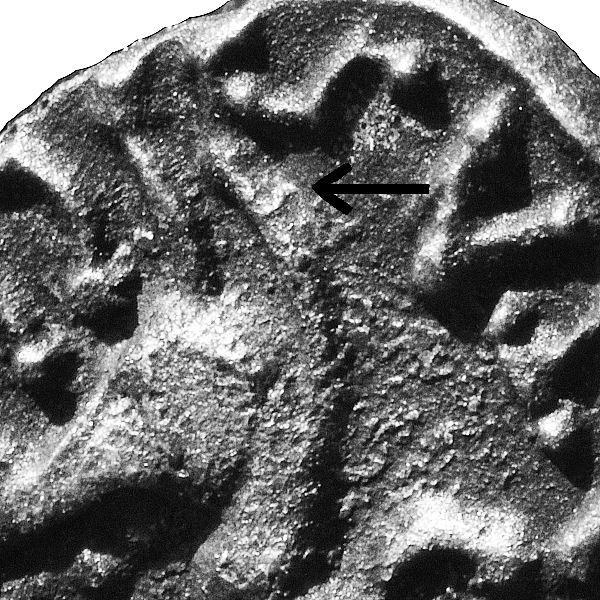
At this point, the coin might pass muster as a badly cleaned but genuine object. Fortunately, the forger failed to dip the coin long enough. Very faint remnants of Haslemere Steps appear on one curve on the reverse (arrow).
This coin should give pause to anyone concerned about authenticity. Had the forger dipped the coin a little longer, it would have fooled almost everyone. It could pass a cursory visual analysis as long as people were willing to accept over-cleaning as an excuse. Those working only from photographs would be at a distinct disadvantage. They would have no reason to expect a fake, and would never perform the analyses required to authenticate the piece. Authentication would entail lengthy stylistic or die-link studies, or expert metallurgical or metallographic analyses.
In summary, these two coins display several more Haslemere errors:
- Split End errors – multiple lines where only one should occur, or lines that split into two or more ends.
- Split Ring errors – circles and pellet-in-ring motifs that show multiple lines, especially ones that fail to mate into a perfect circle.
- Evidence of excessive chemical treatment – weak devices, dark and porous surfaces – where the forger may have tried to hide his errors.
An important reminder is that ancient Celtic die cutters may, on rare occasions, have made the same die cutting mistakes. Authenticators always look for a combination of errors before condemning a coin as a forgery.
End

